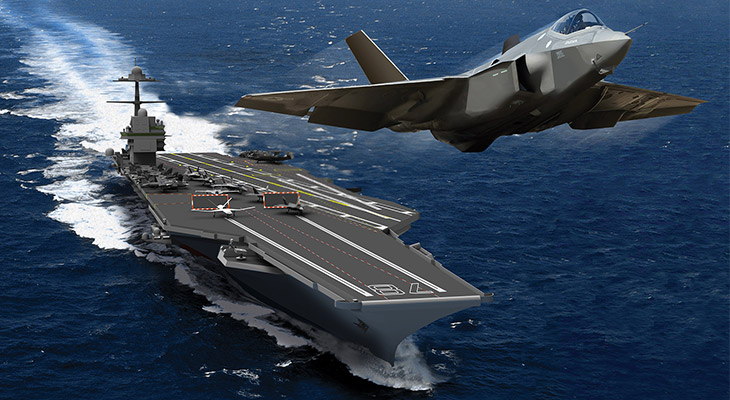
The USS Gerald R. Ford (CVN-78) is Marine Engineering at its best. It houses more than 4 500 crew members and weighs in at 90 000 tons. With a $13 billion price tag, it’s the most expensive and most advanced warship ever built. It certainly sets the bar extremely high.
Christened in November 2013 and scheduled to be commissioned this year, these super-carriers are expected to be in service until 2065. They are also set to replace some of the Navy’s existing Nimitz-class carriers.
Both classes have a similar-looking hull but the Ford class is miles ahead with new technical and technological innovations. Designed to improve operating efficiency and reduce operating costs, the USS Gerald R. Ford also requires fewer crew; about 600 to be more specific. It’s estimated to save $4-5 billion on operational expenditure making it extremely cost effective in comparison.
Although there are some similarities between the two classes, Ford boasts a considerable number of advanced technologies. Take a look below as we compare some aspects of two marine engineering marvels:
Marine Engineering Battle: Nimitz vs Ford Class
Nimitz-class carriers used steam-actuated catapults to launch jets which require a lot of steam pipes, large condensate return and tons of fresh water. This means more maintenance issues like flushing the pipes, repairing damage and leaks for example.
Adding insult to injury, with steam-actuation most of the force is transferred to the airplane with the initial jolt. This puts stress on the frame and in turn reduces lifespan of the multi-million dollar planes.
Ford class uses Electromagnetic Aircraft Launch System or EMALS. It’s a linear induction motor with an electric current generating a magnetic field. This field propels a carriage down a track and since the power delivery is linear, it negates the deficiencies of the previous steam catapult system.
The hydraulic arresting system is installed in the Nimitz class and was designed for traditional carrier based aircraft. The Advanced Arresting Gear (AAG) can work with all current and projected future carrier-based aircraft from the lightest unmanned aerial vehicles to the heaviest manned fighters which makes it far more efficient.
Russian and Chinese carriers are still using ski jumps which is at least one generation behind steam-actuated catapults of the Nimitz and two generations behind EMALS of Ford class. No other carrier is expected to field AAG in the near future which greatly limits their ability to use futuristic Unmanned Combat Air Vehicles (UCAV).
Marine engineering doesn’t get any better than this; the horsepower, torque, offensive and defensive capabilities are completely unmatched.
Nuclear-powered Engines
Ford class has newly designed Bechtel A1B nuclear reactors each one capable of producing 300 MW of electricity, triple the 100 MW of the Nimitz-class. The increase in power supply also allows for future expansions like inducting Lasers and Rail Guns.
They also have fewer valves, piping, pumps and generators meaning reduction in maintenance cost and less space required. Due to it being nuclear, the range is nearly unlimited and they only need to be refueled once in 20 years.
Radar and Flight Missions
The USS Gerald R. Ford has an integrated search and tracking radar system called Active Electronically Scanned Array (AESA). The dual-band radar (DBR) utilizes a multi-tier, dual-band tracker consisting of a local X band, S band and a central tracker. The central tracker merges the two signals to provide a comprehensive situational awareness. Compared to the Nimitz, the new radar requires fewer crew members to operate and also fewer antennas which increase deck space.
The Ford class also has a newly designed deck providing more space for flight operations. It has 3 aircraft elevators instead of 4 in Nimitz but these are far more advanced than on the Nimitz. The result of Automation and superior elevators is impressive. Ford class is capable of generating 30 % more flight missions per day than Nimitz‐class.
Initially the Ford class will have the following in its arsenal:
- 2 squadrons of 10-12 F-35C Joint Strike Fighters
- 2 squadrons of 10-12 F/A-18E/F Super Hornets
- 5 EA-18G Growler electronic attack jets
- 4 E-2D Hawkeye airborne early-warning and control aircraft
- 2 C-2 Greyhound carrier on-board delivery (COD) planes
- 8 MH-60S Seahawk helicopters
Lasers and Rail Guns
Here are two game changing technologies coming soon to the Ford class super-carrier.
The US Navy has recently tested a $40 million, 30-KW laser mounted on the deck of the USS Ponce in the Persian Gulf. Lasers travel at the speed of light so they hit their target almost instantaneously. Not only can they take out a swarm of incoming drones, they can also act as an extremely efficient missile defense system.
The US Navy also test fired a Rail gun which uses electromagnetic energy to fire projectiles at 7-9 times the speed of sound. Unless you have a Rail gun of your own, there is almost no way to counter this attack.
No other country is even close to incorporating this type of technology in their vessels. Marine engineering is at the forefront with really advanced prototypes leading the way. What will be built in the next decade? How much more advanced will the world’s armed forces be?
PRV Engineering manufactures for an expanse of industries including Aerospace and Defense , Oil and Gas, Automotive, Rail, Construction among others. Get in touch if you need help with your project or if you have any questions about our precision engineering one-stop facility.
This site uses Akismet to reduce spam. Learn how your comment data is processed.


 Mail:
Mail: 




Leave a Comments